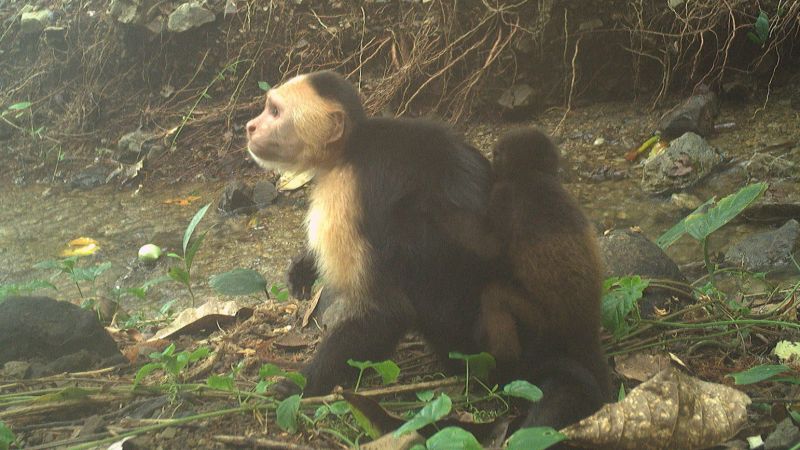In a striking instance of inter-species interaction, Zoë Goldsborough, a behavioral ecologist, made a remarkable observation while reviewing footage from a camera trap set in the natural habitat of capuchin monkeys on Jicarón Island. Initially, she noticed what appeared to be a baby capuchin piggybacking on one of the white-faced capuchins named “Joker.” However, as she scrutinized the clip more closely, something seemed unusual. The animal displayed characteristics indicative of a different species, turning out to be a baby howler monkey instead. This significantly piqued her interest, leading her to contact her research collaborators to delve deeper into the mystery.
As Goldsborough continued her analysis, she uncovered further clips featuring Joker, alongside others of his kind, engaging in similar conduct—carrying baby howler monkeys. Given that howler monkeys are an endangered subspecies (Alouatta palliata coibensis), urgently understanding this unusual behavior became crucial from a conservation perspective. Researchers—including those from the prestigious Max Planck Institute of Animal Behavior and the Smithsonian Tropical Research Institute—began an investigation, combing through 15 months of video footage.
What they found was concerning yet fascinating: a group of male capuchin monkeys had abducted at least 11 infant howler monkeys over a span of just over a year. Strikingly, there was no evidence to suggest that the capuchins were consuming or caring for the infants. Instead, the study authors theorized that this kidnapping behavior represented a “cultural fad” among the capuchins.
Questions arose regarding the implications of the capuchin behavior, as howler monkeys typically have limited reproductive rates, giving birth only once every two years. Therefore, increasing pressure on a dwindling howler population due to predation or behavioral oddities could jeopardize their survival. Goldsborough described the process of examining this case as similar to an emotional roller coaster, filled with shifting interpretations that were constantly corrected as more information came to light.
Jicarón Island, a remote location within Coiba National Park in Panama, is devoid of human habitation, resulting in an erratic schedule for researchers relying on boats to transport gear. The rough terrain hinders direct observations, necessitating the use of camera traps. However, these devices cannot capture live-action within the treetops where howler monkeys typically reside, leaving a significant gap in understanding the dynamics of this peculiar behavior.
Initially viewed as a rare adoption scenario, the researchers quickly ruled this out. Joker was not providing care for the howler infants but merely carrying them, leading to their eventual demise due to starvation. In primatology, it’s not uncommon to find female primates displaying maternal instincts, yet in this case, it was the males exhibiting unusual behaviors absent of typical care associated with nurturing.
Pedro Dias, a primatologist who studies mantled howler monkeys and was not involved in the research, highlighted that such behavior is unexpected among male primates. Behavioral ecologist Corinna Most initially speculated that the capuchins might be predating the infants, but as the study progressed, it became clear that the interactions were minimal, thereby discounting such theories. Instead, the capuchins appeared to be motivated by boredom, influencing their exploratory behavior and leading to the seemingly arbitrary abduction of howler infants.
Island ecosystems, as described by other researchers, can provide unique behavioral adaptations due to the absence of predators. Without the need for caution, the capuchins might be engaging in riskier behaviors out of sheer curiosity. As they become bored, typically the younger males seem to be driving this so-called innovation, challenging previous assumptions about cultural behaviors and their origins among primates.
Goldsborough’s ongoing research investigates how such behaviors may ultimately strengthen social bonds within animal communities, drawing parallels to human cultural evolution, where sometimes, arbitrary traditions may arise without functional purposes. Like their human counterparts, capuchin monkeys might engage in activities that entertain them, raising deeper philosophical questions about inter-species interactions and the ethical implications of their behaviors.
As scientists work to understand these phenomena further, they hope such cultural trends among capuchins do not escalate further, potentially harming the already endangered howler monkeys of Jicarón. As stated by Barrett, this extension of human-like behaviors into the animal kingdom strips a reflective mirror upon human actions that may unintentionally cause distress or harm to other species. Ultimately, these findings underscore the complexities of animal behavior and the necessity for more in-depth study, particularly in the conservation efforts for endangered species.



